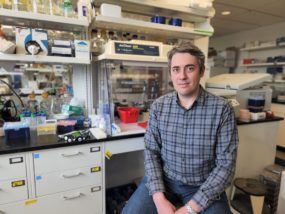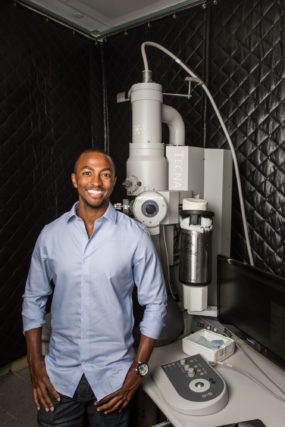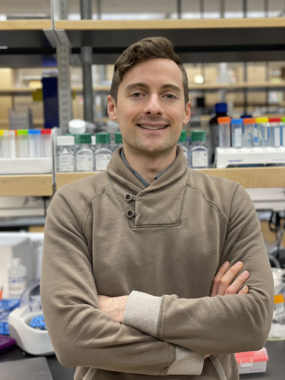
Stories

Announcing the 2022 Rita Allen Foundation Scholars
Major grants will support five pioneering early-career biomedical scientists.
The Rita Allen Foundation has named its 2022 class of Rita Allen Foundation Scholars, celebrating five early-career leaders in the biomedical sciences whose research holds exceptional promise for revealing new pathways to advance human health. The selected Scholars will receive grants of up to $110,000 annually for a maximum of five years to conduct innovative research on critical topics in cancer, immunology, and neuroscience—including how 3D DNA structures in the nucleus of cells impact gene regulation, developing novel molecular tools to understand and analyze brain circuits, and investigating the evolution of the cerebral cortex.
“We are delighted to welcome a new class of remarkable scientists seeking novel solutions to complex problems at the frontier of biological knowledge,” said Elizabeth Good Christopherson, President and Chief Executive Officer of the Rita Allen Foundation. “The COVID19 pandemic made even clearer the importance of decades of biomedical research. The fundamental research these scientists are leading will lay the groundwork for tomorrow’s transformative medicine.”
Since 1976, the Rita Allen Foundation has invested in discovery science—transformative research of above-average risk with promise for outcomes to advance our understanding of human biology—supporting close to 200 biomedical scientists at the early stages of their careers. Scholars have gone on to make fundamental contributions to their fields of study and have won recognition including the Nobel Prize in Physiology or Medicine, the National Medal of Science, the Wolf Prize in Medicine, the Lasker-Koshland Award for Special Achievement in Medical Science, and the Breakthrough Prize in Life Sciences.
The 2022 Scholars were nominated by research institutions in the United States and selected by the Rita Allen Foundation’s Scientific Advisory Committee of leading scientists and clinicians.
The members of the 2022 class of Rita Allen Foundation Scholars are:
Kevin Monahan, Rutgers, The State University of New Jersey
Milton E. Cassel Scholar
Ahmed Abdelfattah, Brown University
Christopher Barnes, Stanford University
Ryan Flynn, Harvard Medical School
Maria Antonietta Tosches, Columbia University

Kevin Monahan
Rutgers, The State University of
New Jersey
Milton E. Cassel Scholar
Assistant Professor; Department of Molecular Biology & Biochemistry
Ph.D., Harvard University
B.S., Haverford College
Kevin Monahan has been designated the Milton E. Cassel Scholar for the 2022 class of Rita Allen Foundation Scholars. This special award honors the memory of a longtime President of the Rita Allen Foundation who passed away in 2004.
In order to fit the long DNA molecules that encode our genome into a tiny nucleus, our cells fold the DNA into complex 3-dimensional structures. This folding does more than save space; it also affects how genes are turned on and off. Intriguingly, different types of cells in the nervous system exhibit distinct 3D nuclear structures. However, the functional significance and regulation of these 3D nuclear structures remains poorly understood. The Monahan lab studies the protein machinery that controls the 3D positioning of genes within the nucleus and how the formation of 3D nuclear structures regulates gene expression. For example, we recently discovered that olfactory sensory neurons, which detect chemical odorants in the air, use the 3D positioning of odorant receptor genes in the nucleus to control the specific type of odorant receptor that they will express. Using molecular, genetic, and genomic approaches, we are investigating protein complexes that regulate 3D nuclear structures in olfactory neurons and in defined populations of neurons within the central nervous system.
What will funding from the Rita Allen Foundation allow you to do?
Funding from the Rita Allen Foundation will allow us to be bold in shifting our focus to new parts of the nervous system. It is now clear that 3D folding of the genome has a key role in controlling olfactory sensory neuron function, but the broader significance of this type of mechanism for neuronal gene regulation remains unclear. We will now be able to pursue intriguing preliminary findings that suggest that some of the same protein complexes that regulate 3D nuclear structure in olfactory sensory neurons may also be at work in specific populations of neurons in the central nervous system.

Ahmed Abdelfattah
Brown University
Robert J. and Nancy D. Carney Assistant Professor of Neuroscience
Ph.D., University of Alberta
B.S., German University of Cairo
Brain circuits are dynamic networks of neurons that process information in the form of electrical and chemical signals to form memories and behaviors. To investigate how brain circuits instantiate fundamental computations underlying behaviors, we need to map their wiring diagrams coupled with functional analysis at cellular resolution to correlate neuron activity with behavior. However, the electrical and chemical signals are not directly visible since there is no natural contrast mechanism that allows us “to see” those signals. The Abdelfattah lab is developing novel classes of molecular tools for large-scale functional analysis and manipulation of brain circuits. In the lab, we repurpose proteins found in nature and engineer them to illuminate brain communication. We hope to use our new molecular tools to unravel the functional basis and causes of neural disorders at a level of detail that has not been accessible to date and empower us to develop novel treatments.
What will funding from the Rita Allen Foundation allow you to do?
Funding from the Rita Allen Foundation will allow us to develop and explore new molecular tools to record brain signals at cellular resolution with millisecond time precision. Our ability to understand the brain is limited by our ability to see and otherwise measure its behavior, particularly in intact brain tissue. Combining the precise molecular specificity of genetically encoded reagents, with the superior spatiotemporal control of light, our proposed tools will reveal how brain circuit dynamics orchestrate behavior over different time scales.
How did you enter this career path? Was there anyone or anything that particularly inspired you?
As a child, I enjoyed building new things and originally wanted to be an engineer. I then learned about molecules and thought it’s more fun to build new molecular tools to understand biology and how our body works. During graduate school, I collaborated with neuroscientists and learned more about the brain and was surprised by how little we know about our own brain. I’m here now thanks to learning a lot from my mentors and colleagues over the years.
What is your favorite science-related book?
That’s a tough one! In graduate school, I read Oliver Sack’s, The Man Who Mistook His Wife For A Hat. Since then, I read more of Oliver Sack’s books. The personal narrative along with seeing every patient as a unique person is wonderful and, in many ways, complements other science books I read.

Christopher Barnes
Stanford University
Assistant Professor, Biology;
Structural Biology
Ph.D., University of Pittsburgh, School of Medicine
M.A., University of North Carolina at Chapel Hill
B.S., University of North Carolina at Chapel Hill
Viruses are inextricably linked to the host cells that they infect. Thus, investigating viral-host interactions is essential to understanding the mechanisms of viral entry, replication, pathogenesis, and the host’s ability to respond to viral pathogens. The Barnes lab excels in leveraging interdisciplinary approaches to address fundamental principles of viral-host interactions for therapeutic benefit. We combine biophysical and structural methods with in vivo approaches to understand how enveloped viruses infect host cells and elicit immune responses. In particular, our research translates knowledge of the structural correlates of antibody-mediated neutralization into the development of highly effective immunotherapies. Additionally, we seek to identify conserved epitopes on viral glycoproteins that are recognized by neutralizing antibodies to facilitate structure-based immunogen design for candidate vaccines against coronaviruses and HIV-1. By combining structural information and improved biochemical methods to mask distracting epitopes, we believe pan-neutralizing vaccines that protect against emerging and re-emerging viral threats are attainable.
What will funding from the Rita Allen Foundation allow you to do?
While progress has been made in establishing regimens that elicit desired antibody responses against HIV-1 in knock-in mice models, we are still at the beginning of our understanding in how to translate these results into wild-type animal models and humans. Funding from the Rita Allen Foundation will enable our lab to investigate broadly-neutralizing antibodies that target a newly identified epitope on the HIV-1 envelope glycoprotein surface called the ”silent face.” Through structure-based design, not only do we believe that we can engineer potent antibody therapeutics whose properties compliment clinical anti-HIV-1 therapeutics, but we also speculate that engineered immunogens based on this region represent an easier path to vaccine design relative to other candidate epitopes.
How did you enter this career path? Was there anyone or anything that particularly inspired you?
From an early age, I always enjoyed science, but didn’t understand what a career as a Ph.D. entailed. As an undergraduate at UNC-Chapel Hill, I majored in chemistry and psychology with every intention of pursuing a medical degree, if it weren’t for my less than average grades. This led me to inquire about undergraduate research opportunities and to the doorstep of Gary Pielak, a pioneer in the field of in-cell protein NMR. He instilled in me a desire to pursue scientific research, to tackle the challenges of tomorrow, and make the discoveries that will lead to advances in human health. Dr. Pielak’s initial mentorship and belief in my abilities—which were further nurtured by outstanding mentoring from my PhD and postdoctoral advisors Guillermo Calero and Pamela Bjorkman, respectively—set me on a career path to where I am today.

Ryan A. Flynn
Boston Children’s Hospital and
Harvard University
Assistant Professor
Pediatrics and the Stem Cell and Regenerative Biology Department
M.D., Ph.D., Stanford University, School of Medicine
B.S., Massachusetts Institute of Technology
Life is made up of many different types of biopolymers such as DNA, RNA, proteins, and carbohydrates. The Flynn Lab studies a hybrid molecule that we discovered called glycoRNA, which is a conjugate of RNA and carbohydrates (glycans). Unlike other RNA species, glycoRNAs are found on the surface of living mammalian cells which places them in an exciting position to control biological processes such as cell-cell communication, host-pathogen interactions, or cell signaling. In the lab, we develop chemical tools and molecular strategies to detect, characterize, and define the functions of glycoRNAs across a range of biological contexts and conditions. Our long-term goal is to control glycoRNA biology for diagnostic and therapeutic benefit.
What will funding from the Rita Allen Foundation allow you to do?
The long-term funding commitment from the Rita Allen Foundation will help support our efforts to explore glycoRNA biology. Exploratory biology is inherently risky, but we are excited by the conceptual opportunities and possibilities cell surface glycoRNAs create by connecting two traditionally separate fields, RNA and glycobiology. With support from the Foundation, we can better ask hard and complex questions of this biology to reveal new aspects of human disease.
How did you enter this career path? Was there anyone or anything that particularly inspired you?
Early on I was inspired by my mother and grandfather, both surgeons, who were able to have a direct and meaningful impact to improve people’s lives. As I learned how knowledge is created and implemented, I realized I wanted to spend my time earlier in the pipeline—focusing on mechanistic problems that I can work on, with others, towards the goal of improving human health.

Maria Antonietta Tosches
Columbia University
Assistant Professor; Department of Biological Sciences
Ph.D., European Molecular Biology Laboratory, Germany
M.S., University of Pisa and Scuola Normale Superiore, Italy
The stunning complexity of our brain is the result of a long journey, that started when squishy and brainless aggregates of cells—the first animals—appeared on Earth over 700 million years ago. Understanding how our brain evolved can shed light on fundamental principles underlying its organization and function. The Tosches lab investigates the evolution of the cerebral cortex, the part of our brain associated with advanced cognition. Focusing on neuron types as units of evolutionary change, we discovered that the mammalian cerebral cortex has a unique neuronal repertoire without clear counterparts in other vertebrates. Our future goal is to understand how changes of developmental programs and gene regulation contributed to the emergence of these new types of neurons in mammals.
What will funding from the Rita Allen Foundation allow you to do?
Research on brain evolution tends to be descriptive because functional experiments can be extremely hard in non-conventional research organisms. To move from descriptive to functional studies on brain development and evolution, we are establishing a new research organism, the salamander, Pleurodeles waltl. Support from the Rita Allen Foundation will enable us to explore the use of new genetic and viral tools in salamanders and will accelerate our research on the evolution of cortical neuron types.
How did you enter this career path? Was there anyone or anything that particularly inspired you?
Born and raised in rural, southern Italy, I became interested in science while watching Italy’s most popular science television program, Superquark. As I was learning how scientists explore big questions in physics, biology, archeology, and medicine, I imagined becoming a scientist myself. This dream started to take shape when I was admitted as an undergraduate student at the Scuola Normale Superiore, an elite Italian university based in Pisa, where scientific research is an integral part of the academic curriculum. The time in Pisa cemented my interests in neuroscience and evolution, and gave me the confidence to pursue postgraduate training abroad. From that point, the dream of becoming a scientist became reality thanks to the constant support and encouragement of several mentors with whom I have had the privilege to work and interact.